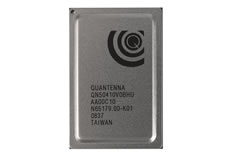MIMO: Less — and More
Posted by Sam Churchill on October 29th, 2008RF Design Line has added a tutorial; Understanding 802.11n.
When a system needs to support multiple users, “multiple access” techniques must be used to divide the communications resources. There are several standard techniques commonly used for multiple access. The first technique uses time division multiple access (TDMA), where all users share the same frequency, but each user listens or talks at a different time. This technique is commonly used in 802.11g radios.
A second technique is to share the frequency. Here, multiple users listen or talk at the same time, but use different frequencies. The third technique uses orthogonal codes to separate multiple users. Here, users use the same frequency at the same time, but special coding is used to separate the multiple users.
802.11n departs from the time, frequency, or code division schemes that came before it; this protocol aims to send data at the same time on the same frequency.
Normally, these signals would interfere with each other. However, 802.11n can take advantage of a concept called “spatial diversity,” which separates the data streams by using multiple antennas.
Spatial diversity uses multiple paths (and ironically, multipath was previously an impairment) to effectively increase throughput. Thus, it is ideal for the cluttered indoor and urban environment. The name given to this technology is MIMO, which stands for multiple-input, multiple-output. Because MIMO systems use multiple radios to achieve higher throughput, these systems can consume more power and have more circuitry compared with single radio (SISO) 802.11g systems.
Atheros says it has a simpler approach to 802.11n — by eliminating MIMO.
Atheros wants to drive 802.11n into mainstream Wi-Fi markets with a new line of chips using a streamlined version of the 802.11n specification, says EE Times. The Atheros Align family uses only a single antenna to target 11g price points.
By stripping out support for multiple radios, Atheros is betting it can create a new class of higher volume 11n devices that hit the estimated $3-5 pricing of 11g parts but deliver better performance, explains EE Times. The Atheros AR9285 single-chip PCI Express (PCIe) solution targets the growing value PC market segment consisting of sub-$500 notebook and netbook products.
 On the other hand, Quantenna (right), puts 4×4 MIMO On a Chip, enabling faster speeds that support high definition video on home Wi-Fi systems.
On the other hand, Quantenna (right), puts 4×4 MIMO On a Chip, enabling faster speeds that support high definition video on home Wi-Fi systems.
The Wi-Fi Alliance is hoping to work out a solution that lets users mix and match different variants of 802.11n. The IEEE’s TASK GROUP N now anticipates publication in November 2009.
source : dailywireless.org



No comments:
Post a Comment